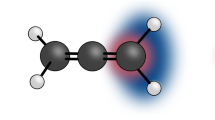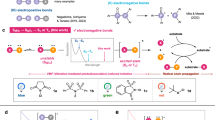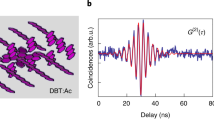Abstract
Two rules have been derived experimentally from investigations of the continuous absorption spectra of inorganic molecules1. First, the action of light may produce the splitting of a single bond, the two products of dissociation, namely, atoms or radicals, possessing free valencies. This process occurs as long as the central atom of the original molecule is in a lower state of valency, molecule formation being brought about by its p electrons only. The first long wave limit then agrees with the single bond energy concerned. The second mechanism refers to molecules the central atom of which is in its maximal state of valency, its s electrons being responsible for chemical linkage in addition to its p electrons. In this case, one of the dissociation products does not possess free valencies, but is a saturated molecule of lower valency state in a 1Σ term. Here, the first long wave limit is not correlated to a single bond energy, but agrees with the energy difference of the total energy of formation of the original molecule and that of the produced molecule of lower valency. In other words, the action of light produces a transition to that repulsive electronic state, which is due to the repulsive character of the s2 group of electrons and predicted by the pair bond theory of valency, originally advanced by Heitler and London.
This is a preview of subscription content, access via your institution
Access options
Subscribe to this journal
Receive 51 print issues and online access
$199.00 per year
only $3.90 per issue
Buy this article
- Purchase on SpringerLink
- Instant access to full article PDF
Prices may be subject to local taxes which are calculated during checkout
Similar content being viewed by others
References
Samuel, R., "Absorption Spectra and Chemical Linkage", Symposium Ind. Acad. Sci. (Bangalore, 1934). Asundi, R. K., and Samuel, R., Proc. Phys. Soc., 48, 28 (1936). Jan-Khan, M., and Samuel, R., ibid., 48, 626 (1936). Parti, Y. P., and Samuel, R., ibid., 49, 568 (1937). Hussain, S. L., and Samuel R., ibid., 49, 679 (1937). Samuel, R., Proc. Ind. Acad. Sci. (Bangalore), 6, 257 (1937).
Henri, V., "Structure des Molecules" (Paris, 1925).
Henri, V. and Schou, S. A., Z. Phys., 49, 774 (1928).
Author information
Authors and Affiliations
Rights and permissions
About this article
Cite this article
BERGMANN, E., SAMUEL, R. Mechanism of the Primary Photodissociation Processes of Organic Molecules. Nature 141, 832–833 (1938). https://doi.org/10.1038/141832b0
Issue date:
DOI: https://doi.org/10.1038/141832b0



